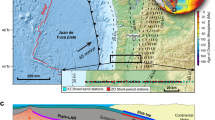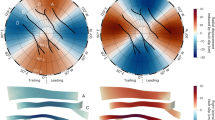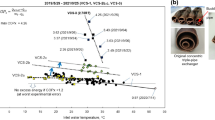Abstract
Many violent eruptions are driven by rapid exsolution of dissolved volatiles within liquid magma. The accelerating two-phase mixture emerges at the vent as a sustained quasi-steady discharge lasting for periods from hours to days (refs 1, 2). The initial growthin discharge rate commonly observed2,3,4, subsequent fluctuations5,6 and discrete pulses and shocks7 remain largely unexplained. We have simulated volcanic conduit flows by producing sustained, quasi-steady explosions in a liquid undergoing rapid exsolution of a gas. This was done by rapidly decompressing large volumes of CO2-saturated water. The results reveal fluctuations in discharge rate that reflect heterogeneities in the two-phase mixture that form spontaneously as a consequence of the size and geometry of the experimental system. An initial transient with a growing discharge rate is observed in experiments in which material is erupted from a spherical flask up a narrow neck that mimics the magma-chamber/conduit assembly of volcanic systems. The fragmentation region propagates down the neck during the initial transient until it reaches a stable position at the top of the flask, at which point a quasi-steady discharge ensues.
This is a preview of subscription content, access via your institution
Access options
Subscribe to this journal
Receive 51 print issues and online access
$199.00 per year
only $3.90 per issue
Buy this article
- Purchase on Springer Link
- Instant access to full article PDF
Prices may be subject to local taxes which are calculated during checkout




Similar content being viewed by others
References
Walker, G. P. L. Plinian eruptions and their products. Bull. Volcanol. 44, 223–240 (1981).
Carey, S. & Sigurdsson, H. The intensity of plinian eruptions. Bull. Volcanol. 51, 28–40 (1989).
Carey, S. & Sigurdsson, H. Temporal variations in column height and magma discharge rate during the 79 AD eruption of Vesuvius. Bull. Geol. Soc. Am. 99, 303–314 (1987).
Wilson, L. Relationships between pressure, volatile content and ejecta velocity in three types of volcanic explosion. J. Volcanol. Geotherm. Res. 8, 297–313 (1980).
Carey, S. et al. Variations in column height and magma discharge during the May 18 1980 eruption of Mount St Helens. J. Volcanol. Geotherm. Res. 43, 99–112 (1990).
Gardner, J. E., Sigurdsson, H. & Carey, S. N. Eruption dynamics and magma withdrawal during the plinian phase of the Bishop tuff eruptions, Long Valley caldera. J. Geophys. Res. 96, 8097–8111 (1991).
Sparks, R. S. J. & Wilson, L. Explosive volcanic eruptions. 5. Observations of plume dynamics during the 1979 Soufriere eruption, St Vincent. Geophys. J. R. Astron. Soc. 69, 551–570 (1982).
Mader, H. M. et al. Experimental simulations of explosive degassing of magma. Nature 372, 85–88 (1994).
Mader, H. M. et al. Dynamics of explosive degassing of magma: Observations of fragmenting two-phase flows. J. Geophys. Res. 101, 5547–5560 (1996).
Anilkumar, A. V., Sparks, R. S. J. & Sturtevant, B. Geological implications and applications of high velocity two-phase flow experiments. J. Volcanol. Geotherm. Res. 56, 145–160 (1993).
Phillips, J. C. et al. Gum rosin-acetone system as an analogue to the degassing behaviour of hydrated magmas. Bull. Volcanol. 57, 263–268 (1995).
Hill, L. G. & Sturtevant, B. in Adiabatic Waves in Liquid-Vapor Systems (eds Meier, G. E. A. & Thompson, P. A.) 25–37 (Springer, Berlin, (1990)).
Sugioka, I. & Bursik, M. Explosive fragmentation of erupting magma. Nature 373, 689–692 (1995).
Dobran, F. Nonequilibrium flow in volcanic conduits and application ot the eruptions of Mt St Helens on May 18, 1980 and Vesuvius in AD 79. J. Volcanol. Geotherm. Res. 49, 285–311 (1992).
Barclay, J., Riley, D. S. & Sparks, R. S. J. Analytical models for bubble growth during decompression of high viscosity magma. Bull. Volcanol. 57, 422–431 (1995).
Papale, P. & Dobran, F. Magma flow along the volcanic conduit during the plinian and pyroclastic flow phases of the May 18, 1980, Mount St Helens eruption. J. Geophys. Res. 99, 4355–4373 (1994).
Sparks, R. S. J. The dynamics of bubble formation and growth in magmas: a review and analysis. J. Volcanol. Geotherm. Res. 3, 1–37 (1978).
Wilson, L., Sparks, R. S. J. & Walker, G. P. L. Explosive volcanic eruptions. IV. The control of magma properties and conduit geometry on eruption column behaviour. Geophys. J. R. Astron. Soc. 63, 117–148 (1980).
Rutherford, M. J. & Devine, M. J. The May 18, 1980, eruption of Mount St Helens. 3. Stability and chemistry of amphibole in the magma chamber. J. Geophys. Res. 93, 11949–11959 (1988).
Acknowledgements
We thank L. Wilson for comments. E.B. was supported by a National Science Foundation graduate fellowship.
Author information
Authors and Affiliations
Corresponding author
Rights and permissions
About this article
Cite this article
Mader, H., Brodsky, E., Howard, D. et al. Laboratory simulations of sustained volcanic eruptions. Nature 388, 462–464 (1997). https://doi.org/10.1038/41306
Received:
Accepted:
Issue Date:
DOI: https://doi.org/10.1038/41306
This article is cited by
-
Flow instabilities in two-phase or supercritical crust fluids and its possible relevance to seismo-electromagnetic disturbances
Natural Hazards (2018)
-
Transient discharges from marine hydrocarbon seeps: spatial and temporal variability
Environmental Geology (2004)
Comments
By submitting a comment you agree to abide by our Terms and Community Guidelines. If you find something abusive or that does not comply with our terms or guidelines please flag it as inappropriate.



